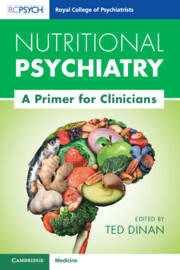Book contents
- Nutritional Psychiatry
- Nutritional Psychiatry
- Copyright page
- Contents
- Contributors
- Preface
- Chapter 1 Basic Principles of Nutrition
- Chapter 2 Diet and the Microbiome–Gut–Brain Axis
- Chapter 3 The Mediterranean Diet and Mental Health
- Chapter 4 Psychobiotics and Fermented Foods
- Chapter 5 Diet Interventions for Anxiety and Depression
- Chapter 6 Schizophrenia, Microbiota and Nutrition
- Chapter 7 Recognising the Importance of Nutrition for Child and Adolescent Mental Health
- Chapter 8 Old Age and Nutrition
- Chapter 9 Broad-Spectrum Micronutrients and Mental Health
- Chapter 10 Epigenetics
- Index
- References
Chapter 10 - Epigenetics
Published online by Cambridge University Press: 17 August 2023
- Nutritional Psychiatry
- Nutritional Psychiatry
- Copyright page
- Contents
- Contributors
- Preface
- Chapter 1 Basic Principles of Nutrition
- Chapter 2 Diet and the Microbiome–Gut–Brain Axis
- Chapter 3 The Mediterranean Diet and Mental Health
- Chapter 4 Psychobiotics and Fermented Foods
- Chapter 5 Diet Interventions for Anxiety and Depression
- Chapter 6 Schizophrenia, Microbiota and Nutrition
- Chapter 7 Recognising the Importance of Nutrition for Child and Adolescent Mental Health
- Chapter 8 Old Age and Nutrition
- Chapter 9 Broad-Spectrum Micronutrients and Mental Health
- Chapter 10 Epigenetics
- Index
- References
Summary
Like microorganisms, the human subspecies can be characterised by subtle differences at the genomic and epigenomic levels. The divergence is due to epigenetic adaptations to variations in environmental conditions and dietary staples. It is evident that environments or food choices which may be essential to sustain life in one population may be toxic to another. However, the recognition of evolutionary biodiversity has been largely ignored with universal nutritional standards and fortification of dietary staples with epigenetic modulators. Because of environmental concerns, global consumption of plants as a primary food is rising; epigenetic adaptation of biological pathways and microbiomes is required to adjust for the loss of bioactive molecules previously obtained from animal-based diets. The resulting epigenetic inflexibility may lead to over- or under-compensation of biological pathways and disease.
This chapter discusses the modern interpretation of epigenetics as the complex plasticity of the epigenome and its DNA sequence, demonstrating the potential for modulation of epigenetic pathways through nutritional, microbiome and environmental modifications.
- Type
- Chapter
- Information
- Nutritional PsychiatryA Primer for Clinicians, pp. 172 - 211Publisher: Cambridge University PressPrint publication year: 2023



